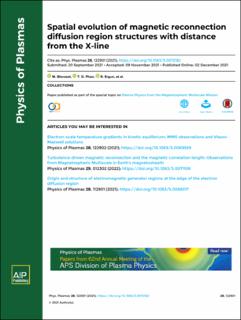Spatial evolution of magnetic reconnection diffusion region structures with distance from the X-line
Oieroset, M; Phan, Tai D.; Ergun, R.E.; Ahmadi, N.; Genestreti, K.; Drake, J. F.; Liu, Y.; Haggerty, CM; Eastwood, JP; Shay, M.A.; Pyakural, P.; Haaland, Stein Egil; Oka, M; Goodbred, M; Eriksson, S; Burch, J. L.; Torbert, R; Khotyaintsev, Y; Russell, C. T.; Strangeway, R; Gershman, D.J.; Giles, B. L.
Journal article, Peer reviewed
Published version

Åpne
Permanent lenke
https://hdl.handle.net/11250/2990727Utgivelsesdato
2021Metadata
Vis full innførselSamlinger
Sammendrag
We report Magnetospheric Multiscale four-spacecraft observations of a thin reconnecting current sheet with weakly asymmetric inflow conditions and a guide field of approximately twice the reconnecting magnetic field. The event was observed at the interface of interlinked magnetic field lines at the flank magnetopause when the maximum spacecraft separation was 370 km and the spacecraft covered ∼1.7 ion inertial lengths (di) in the reconnection outflow direction. The ion-scale spacecraft separation made it possible to observe the transition from electron-only super ion-Alfvénic outflow near the electron diffusion region (EDR) to the emergence of sub-Alfvénic ion outflow in the ion diffusion region (IDR). The EDR to IDR evolution over a distance less than 2 di also shows the transition from a near-linear reconnecting magnetic field reversal to a more bifurcated current sheet as well as significant decreases in the parallel electric field and dissipation. Both the ion and electron heating in this diffusion region event were similar to the previously reported heating in the far downstream exhausts. The dimensionless reconnection rate, obtained four different ways, was in the range of 0.13–0.27. This event reveals the rapid spatial evolution of the plasma and electromagnetic fields through the EDR to IDR transition region.
